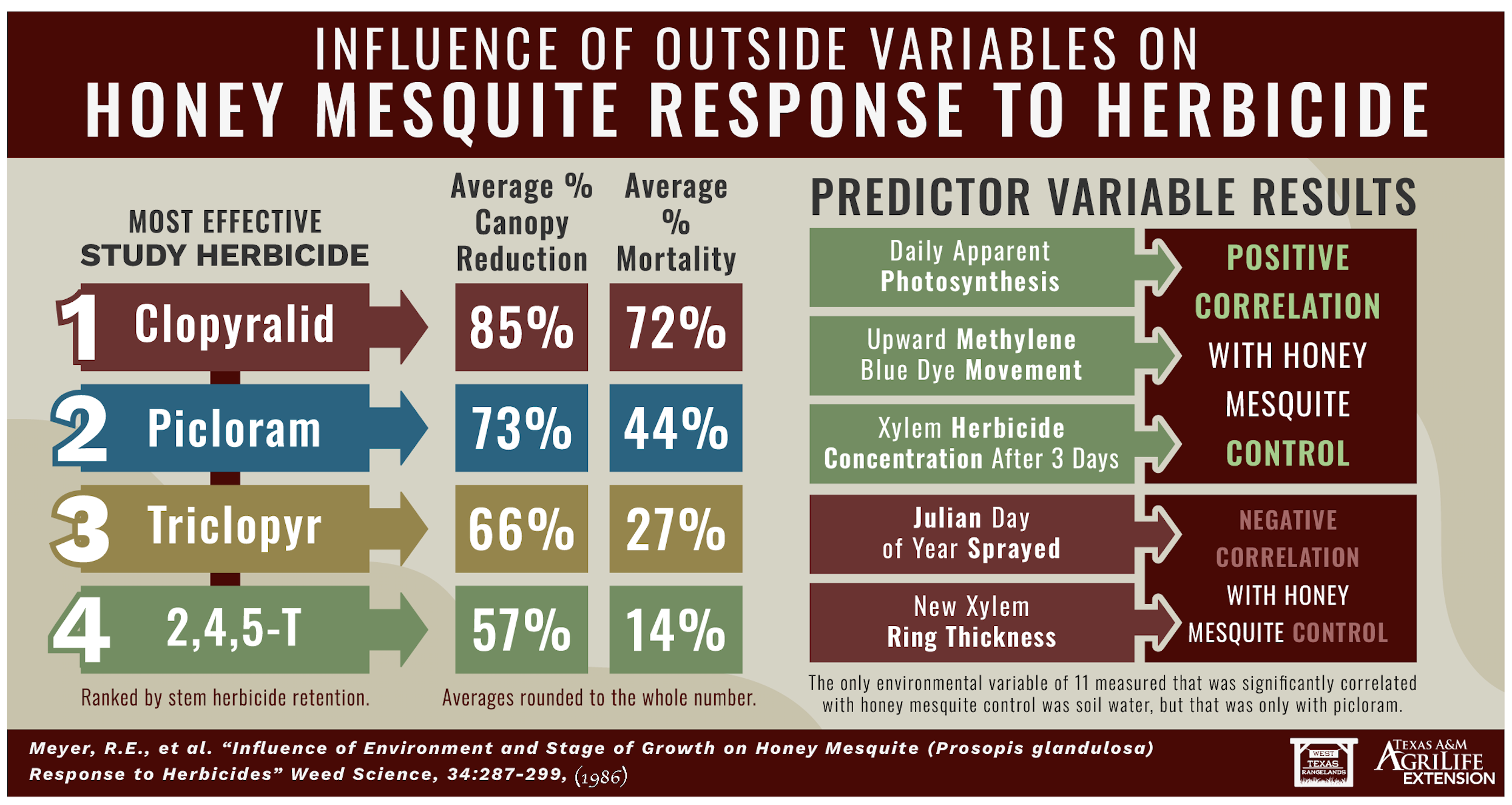 Honey mesquite varies widely in its response to herbicides. Previous research demonstrates most effective treatments have occurred about 50 to 90 days after the first leaves appear in the spring when they are fully formed and dark green (Bovey and Mayeux, Jr. 1981; Jacoby and Meyers 1983; Meyer et al., 1986). More recently, triclopyr has been found to be effective for control of honey mesquite (Bovey and Mayeux, Jr. 1981; Jacoby et al., 1981; Jacoby and Meadors 1983). Also, clopyralid has been found to be highly effective for controlling honey mesquite (Bovey and Mayeux, Jr. 1981; Jacoby et al., 1981).
Honey mesquite varies widely in its response to herbicides. Previous research demonstrates most effective treatments have occurred about 50 to 90 days after the first leaves appear in the spring when they are fully formed and dark green (Bovey and Mayeux, Jr. 1981; Jacoby and Meyers 1983; Meyer et al., 1986). More recently, triclopyr has been found to be effective for control of honey mesquite (Bovey and Mayeux, Jr. 1981; Jacoby et al., 1981; Jacoby and Meadors 1983). Also, clopyralid has been found to be highly effective for controlling honey mesquite (Bovey and Mayeux, Jr. 1981; Jacoby et al., 1981).
Honey mesquite was treated with four different herbicides over a two year period. Clopyralid was the most effective herbicide killing 80% or more of the honey mesquite at most of the 14 dates that it was used (May 5 – September 22) near Bryan, Texas. The overall average mortality rate for Clopyralid was 72%. The second most effective herbicide was Picloram, with an average of 44% mortality rate.
Honey mesquite control was correlated with Julian day of year sprayed, 15 plant, 11 environmental, and 8 herbicide concentration variables. Most effective control was negatively correlated with Julian day of year sprayed and new xylem ring thickness. Control was positively correlated with total daily apparent photosynthesis, upward methylene blue dye movement in the xylem, and herbicide concentration in the xylem 3 days after spraying. The only environmental variable of 11 measured that was significantly correlated with honey mesquite control was soil water and that was only with picloram.
What does this all mean? This research and others (Dahl et al. 1971) and Meyer et al. (1973 and 1983) showed that early in the growing season increasing levels of honey mesquite control were positively related with warming soil temperature, adequate soil moisture, and a complete complement of enlarging leaves. Subsequently, soil temperature continues to increase without a progressive increase in herbicide effectiveness. Thus, May and June are generally periods with adequate soil and air temperature and soil moisture for plant growth. During this time, radial enlargement is proceeding most rapidly causing the stem and root to form a sink for new photosynthates and foliar translocated herbicides. This particular research showed mesquite mortality was linked to higher daily photosynthesis, more upward movement of dye in the xylem, and higher herbicide levels in the xylem three days after spraying.
Biggest take home? Healthy trees with full leaf and in mature phenology that are actively photosynthesizing are a green light to spray, regardless of the calendar day.
For more information and the full study, be sure to check it out – Influence of Environment and Stage of Growth on Honey Mesquite Prosopis glandulosa Response to Herbicides
Meyer, R.E. et al. “Influence of Environment and Stage of Growth on Honey Mesquite (Prosopis glandulosa) Response to Herbicides” Weed Science, 34:287-299, (1986).